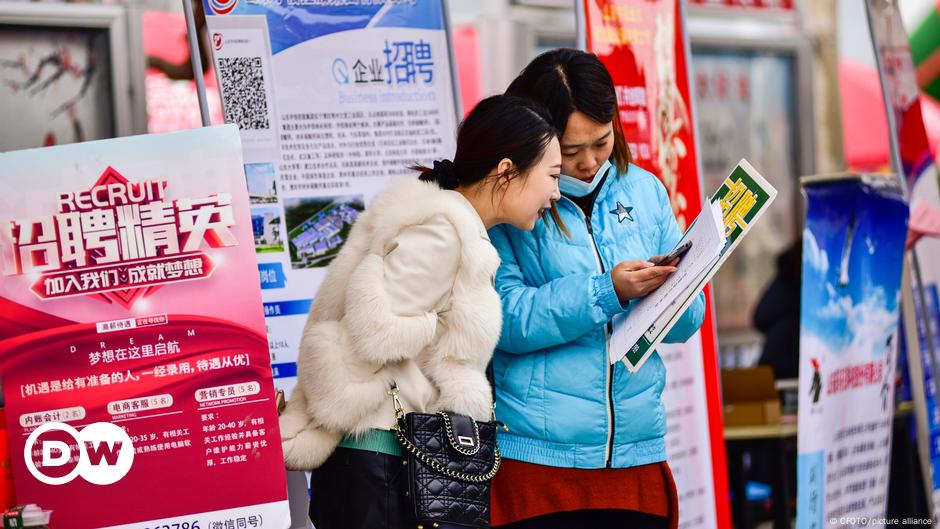China’s youth unemployment: Young people shun new rat race – DW – 02/27/2023
China is currently hosting hundreds of in-person job fairs for the first time in three years — another sign that President Xi Jinping’s draconian zero-COVID policy is history.
The events are packed. The most-slack labor market in years has given employers the advantage while among the many candidates, competition is fierce.
As the country reopens, unemployment — which peaked at 6.2% during the first year of the pandemic and again last May (6.1%) — is on course to slide. But analysts say the labor market recovery could be uneven, as different sectors of the world’s second-largest economy rebound at varying speeds.
Youth unemployment is, however, a major sticking point for Beijing. By international standards, the jobless figure among young Chinese people in urban areas was already high before the virus hit at around 13% and peaked last July when nearly 1 in 5 of those aged between 15 and 24 were out of work.
Finding a job is a tough gig for young Chinese
“This is probably the worst time in the last two decades for young people in China to either regain employment or find their first jobs,” Kevin Lin, a researcher and the Managing Editor of Asian Labour Review, told DW.
Twenty years of unprecedented growth in China generated a huge number of jobs. But as the country shifted from low-cost manufacturing to a service economy dominated by high-technology exports, youth unemployment climbed much faster than for other demographics.
To add insult to injury, Beijing announced a crackdown on the tech, education, entertainment and real estate sectors during the pandemic which spurred large-scale layoffs.
Gaming giant Tencent, online retailer Alibaba and social media firm Weibo — big employers of young, highly educated Chinese workers — have all announced job cuts in recent months. As the property downturn took hold from the China Evergrande debt scandal in 2021, one real estate developer last year fired 90% of its staff.
“As the private sector is the main driver of job creation, the employment situation for Chinese youth will ultimately depend on whether the post-COVID policies can effectively support the private sector and how confident private entrepreneurs are in the current business environment,” Zhao Litao, a senior research fellow at the East Asian Institute, National University of Singapore, told DW.
A slowing global economy, which many economists expect will tip into recession later this year, is likely to stymie demand for Chinese exports. Doubts also remain about how fast China’s reopening can ramp up while the virus is still a threat.
Education in China offered a ‘holding pattern’ for youth
Some think Beijing has hidden the true scale of youth unemployment for decades, pointing to a move to boost college enrollment after the Asian financial crisis of the late 1990s, which saw the number of new students rise by over 40% in a single year.
By 2021, around 44 million undergraduate students were enrolled in degree programs at public colleges and universities in China, compared to some 4 million at the turn of the century.
“For those without the credentials for college, vocational schools teach nothing and are just another part of the holding pattern,” for young people, said Dorothy J. Solinger, Professor Emerita, Department of Political Science, at the University of California, Irvine.
“Serious attention needs to be paid to putting the educational system into sync with the jobs on offer,” she added.
The Chinese government has announced measures to encourage firms to hire younger workers, offering training subsidies and more apprenticeship schemes. Young graduates can also receive funding for their own startups.
But any labor market reforms and stimulus measures take time to reverberate through a country with a 1.4 billion population when the number one priority has been to stamp out COVID-19.
With China’s economy no longer growing in double digits, upward mobility has also started to reverse while competition for jobs has grown more ardent in a society where the pressure to succeed remains high.
Ambition curtailed, many Chinese seek other options
During COVID-19 lockdowns, however, many young people began to reject the prospect of corporate careers — eschewing the rat race for lower-paid, more fulfilling work. The phenomenon is known as tang ping or lying flat.
“Lying flat reflects an understandable mood among young workers who have given up trying,” said Lin. “The question is whether they can afford to really lay flat. China is not a welfare state and does not have mechanisms to support unemployed young people.”
Tang ping also marks a reversal from an era when young migrant workers from rural areas of China moved to big cities, with the sole purpose of supporting their families. Many young people now want less stress and more leisure time.

The long gap between finishing education and starting work has given them a chance to reprioritize their life goals. Many have started small businesses, volunteered at home or abroad, or chosen to freelance, Zhao explained.
“This reflects value changes as the Chinese society and families are more accepting of slow and delayed entry into employment,” she said.
Chinese civil service offers little protection
With fewer private sector jobs available, young Chinese graduates are sitting the civil service exam in record numbers. Until recently, they had shunned the public sector.
But even the promise of job security was short lived due to the massive upheaval caused by COVID-19. Over the past three years, China’s local governments have spent much of their budgets fighting the virus and have been forced to adopt austerity measures, including their own large-scale layoffs.
Edited by: Rob Mudge
For all the latest business News Click Here

